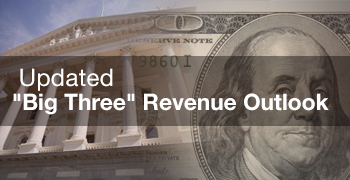
A Look at County Level Domestic Migration March 5, 2018
This post explores migration between California's 15 most populous counties and other states.
February 2018 Cap-and-Trade Auction Results March 1, 2018
We discuss the results of the February 2018 cap-and-trade auction.
California Losing Residents Via Domestic Migration February 21, 2018
This post explores trends in migration between California and other states.
January 2018 State Tax Collections February 13, 2018
We discuss preliminary data on January 2018 state tax collections.
December Major Taxes Far Above Projections January 3, 2018
We discuss preliminary data on December 2017 state tax collections.
November 2017 State Revenues December 11, 2017
We have received preliminary data on November 2017 collections of California's major state taxes from the Franchise Tax Board, the California Department of Tax and Fee Administration, and the Employment Development Department.
October 2017 State Jobs Report December 1, 2017
California's Employment Development Department and the U.S. Bureau of Labor Statistics released California's October 2017 state jobs report on November 17, 2017.
Fiscal Outlook: Focus on Revenues November 15, 2017
We discuss the near-term and multiyear revenue estimates in our publication, The 2018-19 Budget: California's Fiscal Outlook.
Fiscal Outlook: Key Economic Assumptions November 15, 2017
We show the key economic assumptions underlying our new Fiscal Outlook for California.
Fiscal Outlook: Property Taxes Exceed Budget Expectations November 15, 2017
Our new Fiscal Outlook projects that school property taxes will be notably higher than assumed in the 2017-18 Budget Act.
Industry Wage Growth in California November 8, 2017
In this post, we describe trends in industry wages in California between 1990 and 2016.
October 2017 State Revenues November 1, 2017
We received preliminary data on October 2017 collections of California's major state taxes.
September 2017 State Revenues October 5, 2017
We have received preliminary data on September 2017 collections of the state's major taxes.
August 2017 State Revenues September 18, 2017
We have received preliminary data from the tax agencies on August 2017 collections of the state's major tax revenues.

















